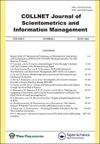Bibliographic coupling and types of centralities: A review of ASME journals - 2000 to 2020
IF 0.8
Q2 INFORMATION SCIENCE & LIBRARY SCIENCE
COLLNET Journal of Scientometrics and Information Management
Pub Date : 2022-01-02
DOI:10.1080/09737766.2022.2063090
引用次数: 0
Abstract
The present study deals with one of the three primary citation analysis methods, i.e., bibliographic coupling. It is believed that the two with the more common references are more related and have similar research interests. The study examined the author’s bibliographic coupling structure with the help of network analysis metrics and found a stronger association between the authors who contributed to the ASME journals. The analysis was conducted at the global level and the local level. In the global level analysis, the bibliographic coupling network analysed by the metrics like average degree, average weighted degree, the diameter of the network, average shortest path length, modularity, and average clustering coefficient. The local level analysis deals with cluster wise analysis to find dominant authors with the most bibliographical coupling strength. The top 50 bibliographically coupled authors represented in the study. Different types of centralities are used to retrieve different aspects and roles of authors in bibliographic coupling. Han, Je-Chin has found the highest bibliographic coupling strength with 53789 total link strengths. Zhu, Hui-Ren is the author who influences other authors in bibliographic coupling relation as his closeness centrality is 1.00. Li, Wei is the most prominent author who helps to expand the bibliographical coupling relation as his betweenness centrality is 13008.13. The study shows an individual network of the top ten bibliographically coupled authors and their coupling relation with others.书目耦合和中心性类型:ASME期刊综述- 2000 - 2020
本研究涉及三种主要引文分析方法之一,即书目耦合。据信,参考文献较多的二者关系更密切,研究兴趣相似。这项研究在网络分析指标的帮助下检查了作者的书目耦合结构,发现为ASME期刊撰稿的作者之间有更强的联系。分析是在全球一级和地方一级进行的。在全局层次分析中,通过平均度、平均加权度、网络直径、平均最短路径长度、模块性和平均聚类系数等指标对书目耦合网络进行分析。地方层面的分析采用聚类分析,以寻找具有最大书目耦合强度的主导作者。该研究中排名前50位的书目耦合作者。不同类型的中心被用来检索作者在书目耦合中的不同方面和角色。韩(Han,Je Chin)发现了最高的书目耦合强度,共有53789个链接强度。朱,惠仁是在书目耦合关系上影响其他作者的作家,他的贴近中心度为1.00。李、韦是最突出的有助于拓展书目耦合关系的作家,他的介数中心度为13008.13。这项研究显示了十大书目耦合作者的个人网络及其与他人的耦合关系。
本文章由计算机程序翻译,如有差异,请以英文原文为准。
求助全文
约1分钟内获得全文
求助全文
来源期刊

COLLNET Journal of Scientometrics and Information Management
INFORMATION SCIENCE & LIBRARY SCIENCE-
自引率
0.00%
发文量
11
 求助内容:
求助内容: 应助结果提醒方式:
应助结果提醒方式:


